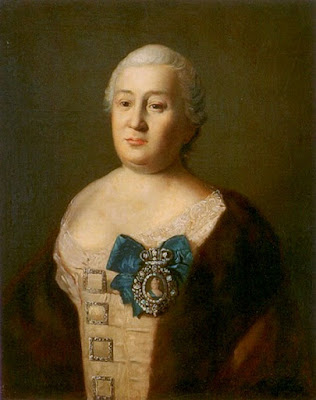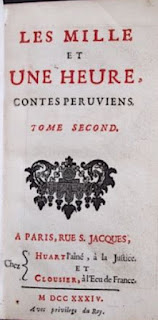004n. Mavra Egorovna Šepeleva (Šuvalova) / Мавра Егоровна Шепелевa (Шувалова)
While
we're on the subject of Anna Ioannovna,
we
might as well pause for a moment to take note of
Mavra Egorovna
Šepeleva
(1708-1759),
who
would
seem to be the next
woman writer in
order of birth
date,
although
she has largely
fallen between the cracks of literary history. Šepeleva
is not mentioned in Golicyn,
for
example (which
I've
indicated by adding an
"n" for "new" to
her number),
but she does appear as
the chronological successor to Natal'ja Alekseevna
in
Lurana O'Malley's review
of eighteenth-century women's
dramaturgy
(17).
Šepeleva
left
a more
evident
trace
in socio-political
history:
her
prominent
career in
elite circles
began
in
1719 with
her
appointment
to the retinue
of
Anna Petrovna, a
distant relation of Anna Ioannovna and
daughter of Peter
the Great.
Most
important,
however, was
Šepeleva's
intimate friendship with Anna Petrovna's
sister, Elizaveta
Petrovna,
who
became Russia's
third
empress in 1741.
After this date, Šepeleva's
influence increased still further:
she
became
a lady-in-waiting
(статс-дама)
at the imperial court and married
the powerful
statesman
Count
Pëtr
Ivanovič
Šuvalov.[1]
It was earlier, however, during the reign of Anna Ioannovna, that Šepeleva tried her hand at playwriting, her "comedy about the Princess Lavra" (о принцессе Лавре) being performed in 1730 or 1731, with Elizaveta Petrovna's choristers and ladies of the court interpreting some of the roles (O'Malley 17). What we know of the play's circumstances comes from the records of an inquest held in 1735 ("Čerta"): Šepeleva's text was examined by authorities when it turned up among the papers of a certain Ivan Petrov who was under official investigation. Petrov was also Elizaveta Petrovna's choirmaster and had a copy of Šepeleva's text in his possession because he himself had played the role of Jupiter. He reported that the comedy had been staged for private audiences at Elizaveta Petrovna's residences in both Moscow and Petersburg ("Čerta" 332).
The inquest documentation also states that Šepeleva's text was written "in Ukrainian" (по малороссийски) ("Čerta" 329). Does this detail affect whether or not we should consider Šepeleva to be a Russian writer? It wouldn't seem to matter much. On one hand, we know that the play was produced in a Russian context, i.e. within the culture of young Elizaveta Petrovna's "court" and for the entertainment of its members. On the other, what exactly does the characterization "Ukrainian" means here? Since no copies of the drama have survived, it is difficult to determine in what idiom it was actually written. Was the play's language truly distinct from Russian of the era? Or was it Russian with a gloss of Ukrainian stylization that aimed at comic effect? Was Šepeleva perhaps borrowing from Ukrainian language dramas that were familiar to her (and perhaps to others in Elizaveta Petrovna's circle)? And/or perhaps the play's language was a reflection – or exaggerated version – of how Šepeleva herself spoke Russian, i.e. with hallmarks of non-native speech? Was "Lavra", whose name rhymes with "Mavra", based on a comedic version of Šepeleva?
Certainly, if we are to judge by the letters that Šepeleva sent to Elizaveta Petrovna from Kiel in 1727-1728, her written Russian left something to be desired.[2] As historian D. L. Mordovcev (330) reminds us, the fact alone that Šepeleva, a woman in the reign of Anna Ioannovna, was able to write anything beyond her own name deserves note. He goes on to praise the "simple, innocent, naive and extremely ungrammatical letters" that have not only "immortalized Šepeleva's name", but are also "more interesting than her entire life" – a strong and extremely provocative claim in light of Šepeleva's later social prominence and political influence. In the absence of Šepeleva's dramatic text, interested students might wish to undertake the translation and/or linguistic analysis of her letters.
FURTHER READING:
O'Malley, Lurana Donnels. "Signs from Empresses and Actresses: Women and Theater in the Eighteenth Century". In Women in Russian Culture and Society, 1700-1825. Edited by Wendy Rosslyn and Alessandra Tosi. Basingstoke: Palgrave Macmillan, 2007. 9-23.
"Čerta iz žizny Imperatricy Elizavety Petrovny", in Russkij archiv (1865), vyp. 3, 329-32.
Šepeleva, Mavra Egorovna. "Pis'ma k Gosudaryne Cesarevne Elisavete Petrovne Mavry Šepelevoj," In Čtenija v Imperatorskom obščestve Istorii i drevnostej rossijskich pri Moskovskom Universitete (1864) kn. 2, 67-72.
"Šuvalova, Mavra Egorovna." In Russkij biografičeskij slovar', vol. 23 (SPb: Tipografija Glavnogo Upravlenija Udelov, 1911): 467-68.
Mordovcev Daniil Lukič. "Grafinja Mavra Egorovna Šuvalova, urožedennaja Šepeleva." Ch. 18 in Russkie ženščiny Novogo vremeni. Biografičeskie očerki iz russkoj istorii. Ženščiny pervoj poloviny XVIII veka. SPb.: A. Čerkesov, 1874, 329-39.
NOTES:
[1] "Šepeleva" thus sometimes appears in historical texts as "Šuvalova", and the name "Mavra" is sometimes Russianized to "Marfa".
[2] Šepeleva traveled to Kiel in attendance on Anna Petrovna, who had married the Duke of Schleswig-Holstein and was pregnant with the future Peter III. This imperial scion later acceded to the Russian throne as Elizaveta Petrovna's heir and ruled for six months before being overthrown by his wife, Catherine II (the Great).
ILLUSTRATIONS:
This portrait of "Lady-in-Waiting Countess Mavra Egorovna Šuvalova (née Šepeleva) with a Portrait of the Empress Elizaveta Petrovna on a moire ribbon" was painted in the late 1750s, perhaps by A. P. Antropov, and is available at www.runivers.ru.




Comments
Post a Comment